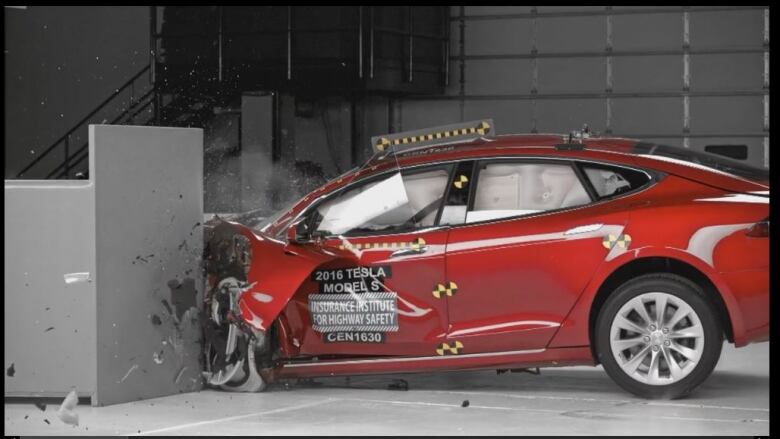Tesla Model S scores well in crash safety tests but falls short of top standard
Electric-car maker docked marks for small overlap crash test and headlights rated 'poor'

Tesla, the electric-car maker with the cult-like following, has missed out on receiving a top safety rating in its first ever crash test ratings by the Insurance Institute for Highway Safety.
"[Tesla] fell a little bit short of the top safety pick bar, but they still represent a pretty high level of safety," says David Zuby, IIHS executive vice-president and chief safety officer.
Tesla says it has already begun updating production models of the Model S with the goal of achieving a top safety rating.
For a new automaker like Tesla, building a positive reputation can make all the difference. Tesla was one of four energy-efficient vehicles evaluated in this round of testing. A second electric vehicle, BMW's i3, also fell just short of the highest standard, while two plug-in hybrids, the Toyota Prius Prime and the Chevrolet Volt, were both awarded the IIHS Top Safety Pick.
Room for improvement
The IIHS is a non-profit organization funded by auto insurers and insurance associations. It's one of two groups in the U.S. performing crash tests on vehicles, the National Highway Traffic Safety Administration being the other.
The IIHS rates the vehicles it tests as "good," "accceptable," "marginal," or "poor." In order to earn the label of IIHS Top Safety Pick a vehicle must earn "good" ratings in each of five separate crash and safety tests.
In Tesla's case, the Model S failed the make the top grade in three areas: small overlap crash test;front crash prevention;and headlight quality.
In the small overlap crash test, the IIHS says the safety belt allowed the crash test dummy's torso to move too far forward.
"The structure of the Model S held up pretty well [but] his head went into the airbag, and then hit the steering wheel through the airbag," says Zuby.
"We recorded some forces on the dummy's head that indicate that a real person might've been injured, if that were to happen in a real crash. And so we downgraded the Tesla's performance from good to acceptable."
Zuby says the injuries suffered would not have been life-threatening for a human driver.
The IIHS also gave the Model S headlights a "poor" rating, although the agency recently toughened its headlightstandards to the point where only 38 models were given the top safety grade in 2016, down from 78 the year before. The IIHS usually tests about 200 vehicles per year.
"With Tesla with the headlights, I was surprised that they ranked so poorly," says automotive journalist Petrina Gentile.
"I mean, that's a failing grade. Headlights are so crucial to safety, especially nighttime visibility. Half of all traffic deaths happen in the dark or at dawn and dusk."
"So I'm really surprised that the headlights aren't a little bit better. Especially when you look at the Model S. It is filled with so much technology. Their Autopilot technology is incredible, it's as close to an autonomous car as you can get."
In a statement emailedto CBC News, a Tesla spokesperson said: "We are committed to making the world's safest cars, and Model S has previously received a five-star safety rating from the National Highway Traffic Safety Administration and a five-star rating from Euro NCAP. Model S still has the lowest ever probability of injury of any car ever tested by NHTSA.
"We proactively develop updates and aggressively implement changes onto the production line in record time any time there is a substantial benefit to customer safety. One of the improvements recently introduced in January 2017 specifically addresses the "acceptable" (or second highest) rating that the Model S achieved in the small overlap frontal crash test, and we expect new tests to yield the highest possible rating ("good" rating) in the crashworthiness category.
Safety critical to sales
The IIHS says the current version of the Model S wasn't rated for front crash prevention because while automatic braking equipment comes standard, Tesla hasn't activated the software for all vehicles.
Tesla'ssaid that in the coming weeks, automatic emergency braking will be deployed via a free over-the-air software update, andIIHSwill be testing a new vehicle.
"We expect to receive the highest possible rating in every category, making Model S eligible for theIIHSTop Safety Pick award," the spokesperson said.
Safety ratings given by both the IIHS and NHTSA are monitored closely by the automakers.
IIHS Top Safety Picks are featured prominently in marketing materials, and auto companies will often make safety improvements to vehicles based on bad results.
"They're big. They're very big. For a manufacturer to have that behind them it sells a lot of cars," says Gentile.
"When you have consumers who are shopping for vehicles, if they're looking at two different vehicles and there is a vehicle that has a top safety pick rating, that could make the difference between them buying that vehicle and not buying it," she says.
Tesla safety questions
Tesla has faced questions about safety in the past, including the death of a 40-year-old man who was using Tesla's Autopilot when his Model S collided with the side of a tractor trailer.An investigation by NHTSA found no "safety-related defect trend" and cleared Tesla.
More recently a Tesla owner claimed his Tesla Model X suddenly accelerated while parked in a garage, causing it to crash into the living room, injuring the driver and a passenger. Tesla says its investigation found the crash to be exclusively caused by the driver "depressing the accelerator pedal all the way to 100 per cent."












_(720p).jpg)


 OFFICIAL HD MUSIC VIDEO.jpg)
.jpg)



























































































